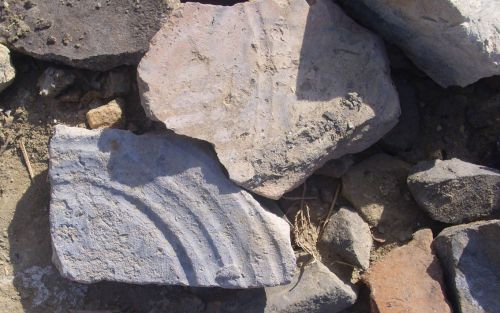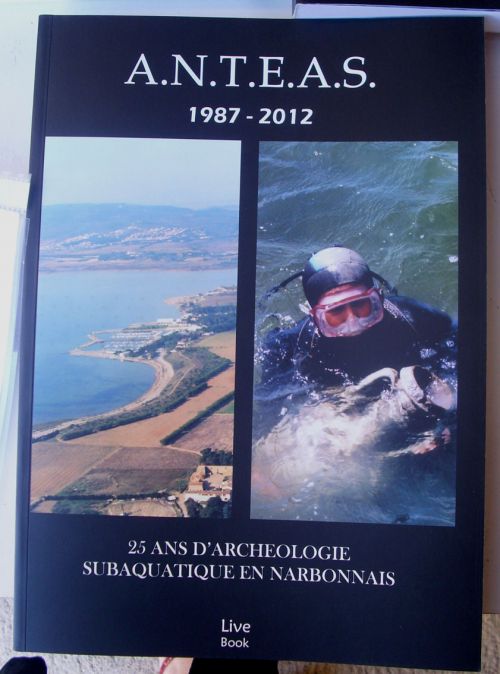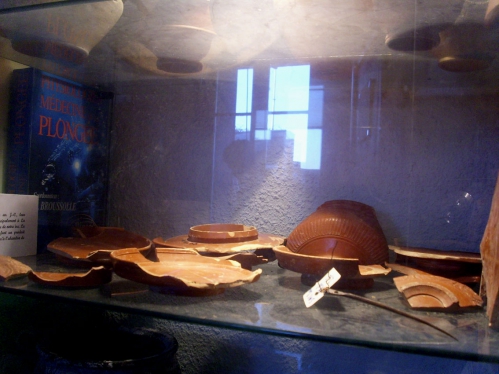LA NAUTIQUE - Castelou
Cutural Heritage Day at Castelou
In the flat area just to the south of La Nautique, Mandirac, stands a converted domain which now belongs to Narbonne and is used to hold educational events for schoolchildren. Every year in mid-September, Narbonne holds it's Cultural Inheritance weekend with various venues open to the public, which includes Castelou, as excavations are taking place there of the nearby Roman port. It's a walk across the marshes of 500 metres to see the excavations.

On the map on the left, the yellow lines represent the quaysides, which are being excavated; from the end of them was a channel or canal connecting with the River Axat in Narbonne, the name of the Aude river in Roman days. When it later changed its course, its bed was used for today's Canal de la Robine. So the boats would arrive at the "Three Bridges" in Narbonne, to offload their cargoes. The picture on the right shows the wood used to built the quays.
The archeologists showed us some great stones that were re-used for the construction of the quays; these stones had come from early Narbonne. 

The newspapers told us that the stones were part of the columns of the great Capitole in Narbonne, but I think they are wrong. These quays at Castelou were abadoned, our guide told us. during the second half of the fifth century. In 462 the great Visigothic King, Euric, had taken Narbonne. The Visigothic Royal family had lived in the Capitole, they would not have taken stones from it to built this port. There's a story that one day in 493, the son of Euric, Alaric II had returned from somewhere to Narbonne to find the new clocktower of St. Felix church, had blocked his favourite view of the countryside. (This is documented.) The bishop was obliged to take down the tower, but afterwards the Good God got his revenge, for he sent bad weather to hide Alaric's view!
This port started to decline after 500, probably because the Visigothic did not have the slave labour that the Romans had. (I think the decorated stones above came from a much smaller house.) Although the Catholic French like to think the Arian Visigoths took places by force, the archeologists have found no signs at battle at Castelou. These docks were merely abandoned.
Returning to the domain we saw a small exhibition of amphores. So many have been found in the étang around la Nautique. 




One carried the mark of he who had made it. Also displayed was this model of the mole at Ma Nautique, showing how it had been constructed. 
The Domain of Castelou is much loved for its position in this maritime countryside, with its flora and fauna. the Domain does much for families and lovers of the open air.
Below - see the birds on the horses' backs. 
In 2012 the Heritage weekend was the 15th and 16th September - and we went back to see how the archeological dig was getting on. 

Something new; the foundations of several port buildings were now visible. The archeologist Corrine Sanchez was our guide. She spoke very clearly and simply (in French) so even those with limited French could understand. 
It was very windy that day and the information sheet blew away and had to be firmly retrieved! 
See the great building blocks used for foundations and quays. 

Beside the track leading to the port, I saw many remains of tegulae. Tegulae (singular - tegula) are the very heavy square roof tiles used by the Romans. So - the foundations and the roofs of the port buildings . . . 


The visit took one hour and we returned to the domain of Castelou to meet Monsieur Jean-Marie Falguère, who is the president of ANTEAS - Association Narbonnaise de Travaux et d'Etudes Archéologique Subaquatiques, or the Narbonne Association for underwater archeological work and studies. ANTEAS were holding a small exhibition, as well as launching their book about their work; 25 years of underwater exploration, between 1987 and 2012. 
 Monsieur Falguère with the book
Monsieur Falguère with the book
Myself and my friends all bought one for 35€. Books are expensive in France, but it was non-profit-making, and it was over 400 pages, incredible work, with full-colour photographs throughout which told the tale much better than words could have done. To buy and learn more, click here.
Monsieur Falguère invited us to the secret warehouse of ANTEAS, to see their finds in December 2012 with a large group of other amateur archeologists. It was incredible! We saw a film of their work and then looked around the warehouse, it was like a tunnel of amphores, thousands of them on shelves either side of us. Everything was clearly labelled after much research; they are among the world's leading authorities on amphores. More valuable finds included statues, coins and the decorated building blocks from the Great Narbonne - which was the capital of Roman Gaul for a long time. Photos were forbidden, to protect the warehouse from vandalism, but they gave me one.
Inscrivez-vous au blog
Soyez prévenu par email des prochaines mises à jour
Rejoignez les 16 autres membres

